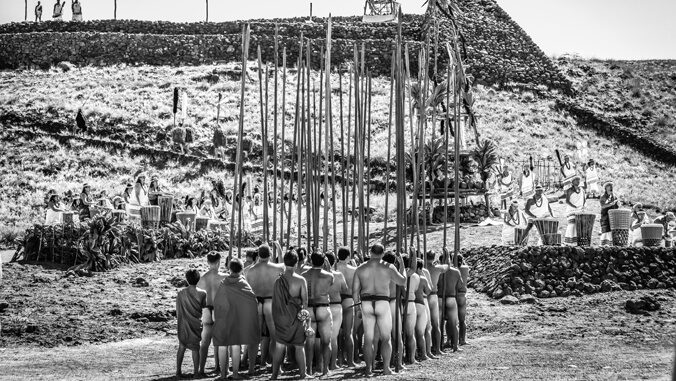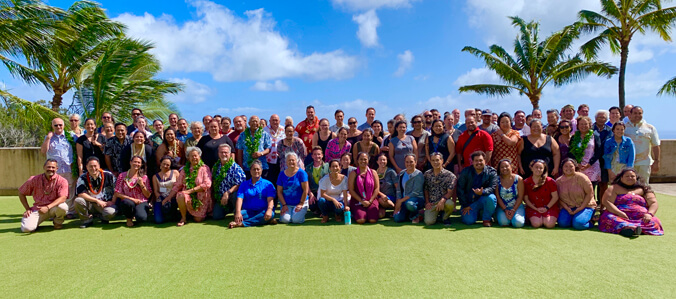
A new collaborative report aimed at revamping the protection of wahi kūpuna or ancestral sites across Hawaiʻi has recently been released to the public. Kumu (teachers) from University of Hawaiʻi at Mānoa, UH Hilo and UH West Oʻahu stemming from a wide umbrella of departments, ranging from anthropology, Hawaiian and American studies and marine and natural resource management participated in developing fresh strategies to safeguard Hawaiʻi’s cultural sites and practices.
“For decades we have witnessed wahi kūpuna, wahi pana (storied or legendary places) and iwi kūpuna (ancestral remains) impacted and destroyed at an alarming rate,” said UH Mānoa and UH Hilo archaeology alumna Kelley Lehuakeaopuna Uyeoka, who helped organize a wahi kūpuna stewardship Think Tank in 2019 through her non-profit organization Huliauapaʻa. “Even today, the news is filled with stories on development projects destroying our sacred places and the bones of our ancestors. Wahi kūpuna are ancestral spaces and places where we maintain relationships to the past, fostering our identity and well-being in the present.”
Collaborators of the newly published Kaliʻuokapaʻakai Collective Report are encouraging the public to read the document to understand what can be done to expand the protection of ancestral sites.
On August 17, an endorsement campaign was launched to encourage people to support the Kaliʻuokapaʻakai Collective’s vision of empowering communities, professionals and agencies to work collaboratively to protect, restore, reinvigorate and appropriately steward Hawaiʻi’s wahi kūpuna.
In April 2019, more than 100 participants from UH and across 15 different sectors attended the two-day Think Tank to discuss a range of challenges, opportunities, and solutions for wahi kūpuna stewardship. Real-time data was compiled through topic area panels, facilitated breakout discussions and live surveys. Participants shared, documented, evaluated and prioritized existing and new information, knowledge and practices. Potential strategies proposed at the event were compiled and published in the report, a first-ever analysis of the current state of cultural resource management and historic preservation in Hawaiʻi.
“Much was accomplished and the Kaliʻuokapaʻakai Collective hopes to hold these types of ‘conferences with kuleana (responsibilities)’ every two to three years to continue to tackle systems change in Hawaiʻi’s cultural resource management field,” said Kamakakūokalani Center for Hawaiian Studies Director Kekuewa Kikiloi, who helped spearhead the event.
The report highlights four topic areas contributors believe Hawaiʻi is facing such as restoration, proper care of burial sites, improvement of consultation with the community and the expansion of ʻike Hawaiʻi (Hawaiian knowledge or thought). The report also lists systemic shortfalls in the current handling of wahi kūpuna which include the lack of digital access to ancestral sites data and severe staffing shortages within the state’s historic preservation division.
Kānaka ʻōiwi (Native Hawaiians) propelled to defend the handling of ancestral lands refer to an array of controversial sites such as the destruction of heiau to make way for the H-3 freeway in Kāneʻohe, construction of a luxury home on top of burials at Naue, Kauaʻi, and the continued push for development on Maunakea.
“This report aims to bring awareness to specific wahi kūpuna stewardship issues and highlight ways that individuals, organizations, professionals and others can take action towards greater stewardship,” Uyeoka added.
E pū paʻakai kākou, a resilient people that can survive together.
According to Kikiloi, the translation of Kaliʻuokapaʻakai breaks down to the deeply symbolic term, “the essence of salt” which illustrates the powerful Hawaiian metaphor of paʻakai (salt) as an agent of protection, preservation, healing and bringing people together. The term was coined by the late Uncle Eddie Kaanana.
“The concept of paʻakai also calls to mind the historical landmark legal case, Ka Paʻakai o ka ʻĀina,, that reaffirmed the traditional and customary rights of Native Hawaiians,” Kikiloi explained.
For more information on the collaborative report and endorsement visit the Kaliʻuokapaʻakai website.

- Related UH News stories:
- Connection to ʻāina critical to health among Native Hawaiians, September 30, 2020
- Journal publishes largest collection of scientific publications by Native Hawaiians, February 11, 2019

